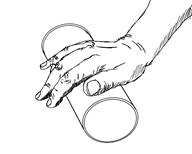renewal cycles. Complete
some now & some later.
and Get 25% off
the Total price!
Buy 3 Courses
and Get 30% off
the Total price!
Buy 4 Courses
and Get 35% off
the Total price!
| Create Account | Login | |

Section 25
Can Rolling
Table of Contents | NCCAP/NCTRC CE Booklet

Assessment for Can Rolling
If the resident’s hand is not totally closed, ask if he or she would lay their hand flat on yours. This helps you to assess if your resident is able to follow a simple direction. Also you can see how flat their hand lies. Sometimes a resident’s hand is almost flat but is actually slightly cupped, which means their hand may be going into a contracture.
It is a challenge to find activities where the resident is flexing their hand back, rather than grasping. The best solution I have found for this type of hand movement problem is an activity called Can Rolling.
Materials and Construction
Can Rolling is exactly what it sounds like. You might use a salt container, Pringles can, or rolling pin for this hand exercise, on the over-the-bed-table. The advantage of the rolling pin is that it’s more identifiable to your resident. However, the diameter is usually smaller than the salt container and the Pringles can. I seem to have better luck with the latter two. Before starting the activity, put a terry cloth towel on the table, so the can won’t just slide around on the surface, but will actually roll.
How to Introduce Can Rolling
Place the resident’s hand on top of the container. Gently help him or her to roll the can back and forth.
Goal: To do Can Rolling after demonstration…
Goal: To do Can Rolling upon request…
Approach: To physically assist the resident in placing their hand on the can…
Once again, as a reminder, notice the angle of your resident’s shoulder, elbow, and wrist to make sure that they are at the most functional angle. Sometimes a resident is a good candidate for Can Rolling, but because of stiffness in these three areas, they are not able to get their hand at the right level or angle with the work surface to successfully roll the can. So assess if any type of rolled-towel-support at the forearm, for example, might facilitate the resident’s success with this activity. Once you get your resident started with Can Rolling, help him or her to apply even pressure to avoid grabbing the can and a scrubbing motion. This grasping, rather than rolling, results in missing the whole goal of the activity, which is to have a backward flex motion in their hand.
To Most Efficiently Utilize Your Time...
while your resident is rolling the can, you might work with a resident sitting nearby on a different activity, while the first resident is either doing, or contemplating doing the Can Rolling.
Don’t Forget O.T. and P.T. Coordination
Success Therapy® Activities need the support and coordination with the Interdisciplinary Team. So if in doubt about using an activity with a particular resident, not only check with nursing, but OT and PT as well.
Residents with whom to try Can Rolling
| Resident | Who will gather materials and/or construct project? |
Staff /Volunteer to work with resident? When? |
|
|
|
|
|
|
Culture Change Implementation: Place Can Rolling in labeled Activity Project Bag left in resident’s room for CNA, volunteer, etc. use.
NCCAP/NCTRC CE Booklet
Forward to Section 26
Back to Section 24
Table of Contents
Top


